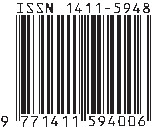The transitivity system of rice ritual texts in Adat Karuhun Urang (AKUR) Sunda Wiwitan community
Abstract
This research article explores the transitivity system of rice ritual texts conducted by the Adat Karuhun Urang (AKUR) Sunda Wiwitan community. This study employs a qualitative research design. The data are rice ritual texts. The data were collected through participant observation and interviews with some elders of AKUR Sunda Wiwitan. The gathered data underwent an analysis utilizing the transitivity system as delineated by Halliday and Matthiessen (2014). The result revealed that the process types contained are material, mental, verbal, relational, behavioural, and existential. The material is the most common type of process, which depicts the actions that people take with the rice and things that happen to the rice. The participants involved are humans, God, a Pwah Aci figure, nature elements, and the state of the ancestors. The circumstances refer to place, time, reason, frequency, quality, comparison, and guise. The place is the dominant aspect of circumstances, which explains where the seeds of rice are planted, where God exists, the origin place of Pwah Aci and where Pwah Aci lives on earth. The rice ritual texts reveal the experiential meaning of a harmonious relationship between humans, God, and nature.
References
Anggraeni, F. D., & Hidayat, R. 2020. “Penguatan Identitas Sebagai Strategi Bertahan Warga Adat Sunda Wiwitan”. Indonesian Journal of Sociology, Education, and Development, 2(2), 75–84. Https://Doi.Org/10.52483/Ijsed.V2i2.27
Anoegrajekti, N., Macaryus, S., Bustami, A. L., Wirawan, R., & Masyithoh, N. 2020. “Ritual as a Conservation Space for Using Language”. IOP Conference Series: Earth And Environmental Science,485(1), 1–8. Https://Doi.Org/10.1088/1755-1315/485/1/012028
Azhima, F. F., Priyatna, A., & Muhtadin, T. 2020. “Mitos dan Representasi Dewi Sri dalam Ritual Sinoman Upacara Adat Mapag Sri di Desa Slangit Kabupaten Cirebon: Kajian Semiotika”.Metahumaniora,10(2),217.Https://Doi.Org/10.24198/Metahumaniora.V10i2.25733
Banks, D. 2002. “Systemic Functional Linguistics as a Model For Text Analysis”. Asp, 35(36), 23–34.
Bowern, C. 2008. Linguistic Fieldwork: A Practical Guide. Pallgrave Macmillan.
Danadibrata, R. A. 2006. Kamus Basa Sunda. Kiblat Buku Utama.
Eggins, S. 2004. An Introduction to Systemic Functional Linguistics (2nd Ed.). Continum International Publishing Group.
Emilia, E. 2014. Introducing Functional Grammar. PT Dunia Pustaka Jaya.
Halliday, M. A. ., & Matthiessen, C. M. I. . 2014. Halliday’s Introduction To Functional Grammar (4th Ed.). Routledge.
Hardiyanti, S., Setiawan, I., Nurmiwati, & Oktaviani, F. S. 2023. “Transitivity Of President Jokowi’s Speech Text At The G20 Event: Systemic Functional Linguistics Study”. Indonesian Journal of EFL and Linguistics, 8(1), 151–168.
Hurriyah, H. 2022. “Local Religions and Contested Civic Space In Indonesia: A Case Study of Sunda Wiwitan Community in Cigugur, West Java.” Proceedings Ofthe 1st International Conference On Emerging Issues In Humanity Studies And Social Sciences, 595–606. Https://Doi.Org/10.5220/0010755800003112
Indrawardana, I. 2014. “Berketuhanan dalam Perspektif Kepercayaan Sunda Wiwitan”. Melintas, 30(1), 105. Https://Doi.Org/10.26593/Mel.V30i1.1284.105-118
Kalsum. 2010. “Kearifan Lokal Dalam Wawacan Sulanjana: Tradisi Menghormati Padi Pada Masyarakat Sunda Di Jawa Barat, Indonesia”. Sosiohumanika, 3(1), 79–94.
Kurnia, L. 2015. ““Seren Taun” Between Hegemony And Culture Industry Reading A Sundanese Ritual Of Harvest In Cigugur, West Java”. Wacana, 15(2), 300. Https://Doi.Org/10.17510/Wacana.V15i2.405
Kurniasih, E., & Nurani, S. 2023. “Sanduk-Sanduk Papalaku in Daily Life of AKUR Sunda Wiwitan Community”. Jurnal Ilmiah Bina Bahasa, 16(2), 126–138. Https://Doi.Org/10.33557/Binabahasa.V16i2.2743
Linh, N. T. N. 2021. “Transitivity Analysis of The Vietnamese Economic Contracts from The Perspective of Systemic Functional Grammar”. VNU Journal of Foreign Studies, 37(6). Https://Doi.Org/10.25073/2525-2445/Vnufs.4723
Mondada, L. 2018. “Transciption In Linguistics”. in L. Litosseliti (Ed.), Research Methods in Linguistics (Second). Bloomsbury Academic.
Prawiyogi, A. G., Dwimarwati, R., Afryanto, S., & Imran, M. E. 2023. “Integration of Local Wisdom Values “Domyak Ritual” in Character Education”. Studies in Learning and Teaching, 4(1), 40–51. Https://Doi.Org/10.46627/Silet.V4i1.189
Qomariah, N. ., Saragih, A. ., & Murni, S. M. 2021. “Transitivity System In CNN Online News. The 6th Annual International Seminar on Transformative Education and EducationalLeadership”(AISTEEL2021),591(1),467–471. Https://Doi.Org/10.24114/Lt.V19i1.34328
Schreier, D. 2013. “Collecting Etnographic and Sociolinguistics Data”. In M. G. Krug & J. Schluter (Eds.), Research Methods in Language Variation and Change (Pp. 17–35). Cambridge University Press.
Subiantoro, I. H. 2017a. “Estetika, Seren Taun Antara Seni, Ritual, dan Kehidupan”. Panggung, 26(4). Https://Doi.Org/10.26742/Panggung.V26i4.212
Subiantoro, I. H. 2017b. “Pergelaran Ritual Seren Taun di Cigugur Kabupaten Kuningan Jawa Barat”. Patrawidya, 18(1), 41–55.
Suhaenah, E., Rohaeni, A. J., & Listiani, W. 2017. “Rekontruksi Pikukuh Tilu dalam Manajemen Babarit pada Upacara Seren Taun Cigugur Kuningan”. Panggung, 27(2). Https://Doi.Org/10.26742/Panggung.V27i2.258
Sutarno, A. 2023. “Seren Taun: Public Communication and Survival Living Sunda Wiwitan”. JAQFI: Jurnal Aqidah dan Filsafat Islam, 8(1), 61–80.
Sutarno, A., Purwanto, S. A., & Gunawijaya, J. 2023. “The Dynamics of Local Religion in Indonesia’s Multireligious Community. Journal of Gender, Culture and Society”, 3(1), 32–41. Https://Doi.Org/10.32996/Jgcs.2023.3.1.4
Wiratno, T. 2021. Pengantar Ringkas Linguistik Sistemik Fungsional. Pustaka Pelajar.

This work is licensed under a Creative Commons Attribution-ShareAlike 4.0 International License.
SEMIOTIKA has CC-BY-SA or an equivalent license as the optimal license for the publication, distribution, use, and reuse of scholarly work. Authors who publish with this journal retain copyright and grant the journal right of first publication with the work simultaneously licensed under a Creative Commons Attribution-ShareAlike 4.0 International License that allows others to share the work with an acknowledgment of the work's authorship and initial publication in this journal.
Attribution-ShareAlike
CC BY-SA










